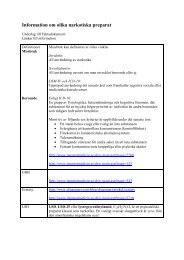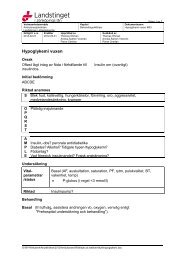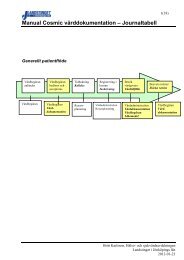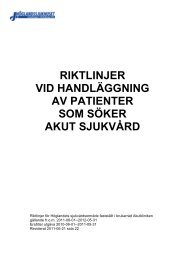Samverkan mellan polis, sjukvård, SOS Alarm och räddningstjänst ...
Samverkan mellan polis, sjukvård, SOS Alarm och räddningstjänst ...
Samverkan mellan polis, sjukvård, SOS Alarm och räddningstjänst ...
Create successful ePaper yourself
Turn your PDF publications into a flip-book with our unique Google optimized e-Paper software.
Determining which situations associated with attempted suicides can require<br />
the assistance of the rescue service is important, since this constitutes a basis<br />
for when the municipal rescue service may commence, or has reason to<br />
commence, a rescue operation. At the same time it constitutes the basis for<br />
decisions as to when the local municipality has an obligation to start a<br />
rescue operation. Not least because of the latter reason it is important not to<br />
unduly stretch the formal terms for rescue operations or the provisions<br />
specified in the Swedish Law on the prevention of accidents (2003:778).<br />
The first limitation comes from the first section of the Law on the<br />
prevention of accidents, namely that this Law does not apply to aspects of<br />
health and medical care as specified in the current health and medical care<br />
legislation. This means that a local rescue service can never be involved in<br />
incidents of suicide or attempted suicide that are of a medical nature such as<br />
poisoning or similar situations.<br />
As regards the threat of jumping from a high level or similar situations the<br />
legal term ‘accident’ ought to be met, or alternatively that there is imminent<br />
danger of an accident. Even here there is scope for various types of<br />
measures that are closely associated with the rescue service’s normal tasks<br />
and abilities. The four criteria specified in the first section of the Law on the<br />
prevention of accidents should probably often be met in these situations,<br />
namely the need for a rapid response, the importance of the interest under<br />
threat, namely a human life, the cost of the rescue operation and other<br />
relevant aspects. The cost of the rescue operation is almost always less<br />
important than the risk to human life, and there is no other private or public<br />
organisation that can respond to such a situation with the appropriate<br />
equipment such as a inflatable jump cushion, turntable ladder, surface<br />
recovery sledge, etc. Each case must therefore be determined on its specific<br />
merits.<br />
The basis of the liaison between the medical authority, the Police, and the<br />
rescues service in connection with the threat of a suicide is that each party<br />
undertakes its own formal operations parallel with the other parties<br />
involved. Considering the police authority’s powers it is appropriate that the<br />
Police contribute to the creation of good conditions for co-operation. Even<br />
in cases where the Police and medical services are involved under the Law<br />
on enforced psychiatric care these actions take place in parallel even if the<br />
rescue service is not involved.<br />
It is therefore important that the party with the practical initiative in the<br />
incident, i.e. the Police, always informs the other parties involved, primarily<br />
the medical authority, the local rescue service, and the municipal social<br />
services department.<br />
In the County of Jönköping a series of resources are automatically alerted<br />
by the <strong>SOS</strong> <strong>Alarm</strong> centre in connection with an emergency 112 call which<br />
indicates a threat of suicide. At the same time as the call is diverted to the<br />
Police, the following units are alerted:<br />
8








